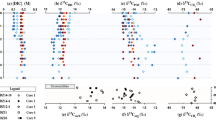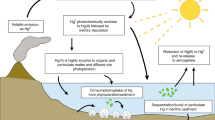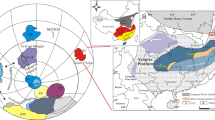Abstract
The Earth's most severe glaciations are thought to have occurred about 600 million years ago, in the late Neoproterozoic era1,2. A puzzling feature of glacial deposits from this interval is that they are overlain by 1–5-m-thick ‘cap carbonates’ (particulate deep-water marine carbonate rocks) associated with a prominent negative carbon isotope excursion3,4,5,6,7,8. Cap carbonates have been controversially ascribed to the aftermath of almost complete shutdown of the ocean ecosystems for millions of years during such ice ages—the ‘snowball Earth’ hypothesis4,5. Conversely, it has also been suggested that these carbonate rocks were the result of destabilization of methane hydrates during deglaciation and concomitant flooding of continental shelves and interior basins3. The most compelling criticism of the latter ‘methane hydrate’ hypothesis has been the apparent lack of extreme isotopic variation in cap carbonates inferred locally to be associated with methane seeps. Here we report carbon isotopic and petrographic data from a Neoproterozoic postglacial cap carbonate in south China that provide direct evidence for methane-influenced processes during deglaciation. This evidence lends strong support to the hypothesis that methane hydrate destabilization contributed to the enigmatic cap carbonate deposition and strongly negative carbon isotopic anomalies following Neoproterozoic ice ages. This explanation requires less extreme environmental disturbance than that implied by the snowball Earth hypothesis4,5.
This is a preview of subscription content, access via your institution
Access options
Subscribe to this journal
Receive 51 print issues and online access
$199.00 per year
only $3.90 per issue
Buy this article
- Purchase on Springer Link
- Instant access to full article PDF
Prices may be subject to local taxes which are calculated during checkout




Similar content being viewed by others
References
Crowell, J. C. Pre-Mesozoic ice ages: their bearing on understanding the climate system. Mem. Geol. Soc. Am. 192 (1999)
Sohl, L. E., Christie-Blick, N. & Kent, D. V. Paleomagnetic polarity reversals in Marinoan (ca 600 Ma) glacial deposits of Australia: implications for the duration of low-latitude glaciations in Neoproterozoic time. Geol. Soc. Am. Bull. 111, 1120–1139 (1999)
Kennedy, M. J., Christie-Blick, N. & Sohl, L. E. Are Proterozoic cap carbonates and isotopic excursions a record of gas hydrate destabilization following Earth's coldest intervals? Geology 29, 443–446 (2001)
Hoffman, P. F., Kaufman, A. J., Halverson, G. P. & Schrag, D. P. A Neoproterozoic snowball Earth. Science 281, 1342–1346 (1998)
Hoffman, P. F. & Schrag, D. P. The snowball Earth hypothesis: testing the limits of global change. Terra Nova 14, 129–155 (2002)
Kennedy, M. J. Stratigraphy, sedimentology, and isotopic geochemistry of Australian Neoproterozoic postglacial cap dolostones: deglaciation, δ13C excursions, and carbonate precipitation. J. Sedim. Res. 66, 1050–1064 (1996)
Kennedy, M. J., Christie-Blick, N. & Prave, A. R. Carbon isotopic composition of Neoproterozoic glacial carbonates as a test of paleoceanographic models for snowball Earth phenomena. Geology 29, 1135–1138 (2001)
James, N. P., Narbonne, G. M. & Kyser, T. K. Late Neoproterozoic cap carbonates: Mackenzie Mountains, northwestern Canada: precipitation and global glacial meltdown. Can. J. Earth Sci. 38, 1229–1262 (2001)
Stakes, D. S., Orange, D., Paduan, J. B., Salamy, K. A. & Maher, N. Cold-seeps and authigenic carbonate formation in Monterey Bay, California. Mar. Geol. 159, 93–109 (1999)
Peckmann, J., Goedert, J. L., Thiel, V., Michaelis, W. & Reitner, J. A compressive approach to the study of methane-seep deposits from the Lincoln Creek Formation, western Washington State, USA. Sedimentology 49, 855–873 (2002)
Cavagna, S., Clari, P. & Martire, L. The role of bacteria in the formation of cold seep carbonates: geological evidence from Monferrato (Tertiary, NW Italy). Sedim. Geol. 126, 253–270 (1999)
Kauffman, E. G., Arthur, M. A., Howe, B. & Scholle, P. A. Widespread venting of methane-rich fluids in Late Cretaceous (Campanian) submarine springs (Tepee Buttes), Western Interior seaway, U.S.A. Geology 24, 799–802 (1996)
Irwin, H., Curtis, C. & Coleman, M. Isotopic evidence for source of diagenetic carbonates formed during burial of organic-rich sediments. Nature 269, 209–213 (1977)
Gautier, D. L. & Claypool, G. E. Interpretation of methanic diagenesis in ancient sediments by analogy with processes in modern diagenetic environments. Mem. Am. Assoc. Petrol. Geol. 37, 111–123 (1984)
Aiello, I. W., Garrison, R. E., Moore, J. C., Kastner, M. & Stakes, D. S. Anatomy and origin of carbonate structures in a Miocene cold-seep field. Geology 29, 1111–1114 (2001)
Grotzinger, J. P. & Knoll, A. H. Anomalous carbonate precipitates: is the Precambrian the key to the Permian? Palaios 10, 578–596 (1995)
Barfod, G. H. & Baker, J. New Lu-Hf and Pb-Pb age constraints on the earliest animal fossils. Earth Planet. Sci. Lett. 201, 203–212 (2002)
Xiao, S., Zhang, Y. & Knoll, A. H. Algae and embryos in a Neoproterozoic phosphorite. Nature 391, 553–558 (1998)
Boetius, A. et al. A marine microbial consortium apparently mediating anaerobic oxidation of methane. Nature 407, 623–626 (2000)
Greinert, J., Bollwerk, S. M., Derkachev, A., Bohrmann, G. & Suess, E. Massive barite deposits and carbonate mineralization in the Derugin Basin, Sea of Okhotsk: precipitation processes at cold seep sites. Earth Planet. Sci. Lett. 203, 165–180 (2002)
Dickens, G. R., Fewless, T., Thomas, E. & Bralower, T. J. Excess barite accumulation during the Palaeocene-Eocene Thermal Maximum: Massive input of dissolved barium from seafloor gas hydrate reservoirs. Spec. Pap. Geol. Soc. Am. 369, 11–23 (2003)
Dickens, G. R., O'Neil, J. R., Rea, D. K. & Owen, R. M. Dissociation of oceanic methane hydrate as a cause of the carbon isotope excursion at the end of the Paleocene. Paleoceanography 10, 965–971 (1995)
Katz, M. E., Pak, D. K., Dickens, G. R. & Miller, K. G. The source and fate of massive carbon input during the Latest Paleocene Thermal Maximum. Science 286, 1531–1533 (1999)
Hesselbo, S. P. et al. Massive dissociation of gas hydrate during a Jurassic oceanic anoxic event. Nature 406, 392–395 (2000)
Kvenvolden, K. A. in Gas Hydrates: Relevance to World Margin Stability and Climate Change (eds Henriet, J. P. & Mienert, J.) 9–30 (Spec. Publ. 137, Geological Society of London, 1998)
Hoffman, P. F., Halverson, G. P. & Grotzinger, J. P. Are Proterozoic cap carbonates and isotopic excursions a record of gas hydrate destabilization following Earth's coldest intervals? Comment. Geology 30, 286–287 (2002)
Acknowledgements
We thank S. H. Zhang, H. C. Wu, G. B. Li and D. M. Liu for field assistance, and D. Mrofka and C. Valkenburg for laboratory assistance in stable isotopic analysis. We also thank M. A. Arthur and J. P. Grotzinger for comments and suggestions. This work was supported by the NSF.
Author information
Authors and Affiliations
Corresponding author
Ethics declarations
Competing interests
The authors declare that they have no competing financial interests.
Supplementary information
Rights and permissions
About this article
Cite this article
Jiang, G., Kennedy, M. & Christie-Blick, N. Stable isotopic evidence for methane seeps in Neoproterozoic postglacial cap carbonates. Nature 426, 822–826 (2003). https://doi.org/10.1038/nature02201
Received:
Accepted:
Issue Date:
DOI: https://doi.org/10.1038/nature02201
This article is cited by
-
Salinity variation and hydrographic dynamics in the early Cambrian Nanhua Basin (South China)
Science China Earth Sciences (2023)
-
Methane hydrate dissociation across the Oligocene–Miocene boundary
Nature Geoscience (2022)
-
First record of sulfate-driven anaerobic methane oxidation and associated dolomite precipitation in Kachchh Basin, western India
Carbonates and Evaporites (2022)
-
Active methanogenesis during the melting of Marinoan snowball Earth
Nature Communications (2021)
-
A Review of the Neoproterozoic Global Glaciations and a Biotic Cause of Them
Earth Systems and Environment (2021)
Comments
By submitting a comment you agree to abide by our Terms and Community Guidelines. If you find something abusive or that does not comply with our terms or guidelines please flag it as inappropriate.



